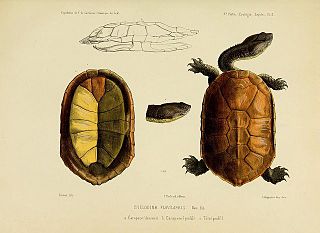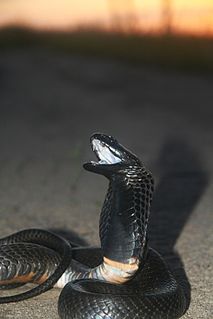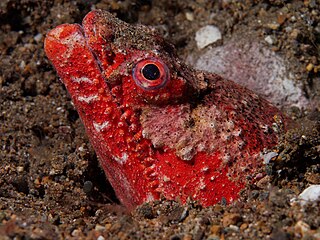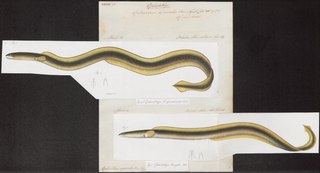Echidnas are Australian egg-laying mammals also known as spiny anteaters.

Cobra is the common name of various elapid snakes, most of which belong to the genus Naja.
Hydrophis spiralis, commonly known as the yellow sea snake, is a species of venomous sea snake in the family Elapidae. H. spiralis feeds primarily on eels and is found in muddy, sandy ocean bottoms.

Diadophis punctatus, commonly known as the ring-necked snake or ringneck snake, is a harmless species of colubrid snake found throughout much of the United States, central Mexico, and southeastern Canada. Ring-necked snakes are secretive, nocturnal snakes, so are rarely seen during the day time. They are best known for their unique defense posture of curling up their tails, exposing their bright red-orange posterior, ventral surface when threatened.

The Argentine snake-necked turtle, also known commonly as the South American snake-necked turtle is a species of turtle in the family Chelidae. The species is known for the long neck to which its common names refer. Despite appearances, the Argentine snake-necked turtle is probably more closely related to the mata mata than to the Australian snake-necked turtles in the genus Chelodina. H. tectifera is found in southern Brazil, and northern Uruguay, Paraguay, and Argentina. Not much is known about it, as it has not been extensively researched. It is a popular pet in the exotic pet trade.

The black-banded sea krait, also known commonly as the Chinese sea snake, is a species of venomous snake in the subfamily Laticaudinae of the family Elapidae. In Japan it is known as erabu umi hebi, and in Okinawa as the irabu. It is found in most of the warm waters of the western Pacific Ocean.

The Brazilian snake-necked turtle, locally known as cágado da serra, and also commonly known as Maximilian's snake-necked turtle, is a species of turtle in the family Chelidae. The species is endemic to southeastern Brazil. It is one of the smallest Brazilian freshwater turtles reaching a maximum straight carapace length of 20 cm (7.9 in). The species prefers streams with sandy and rocky bottoms and clear water in forests above 600 m (2,000 ft) elevation.

Myrichthys maculosus, commonly known as the tiger snake eel, the ocellate snake eel or the spotted snake eel, is a species of fish in the family Ophichthidae, native to the Indo-Pacific. It is occasionally encountered in the aquarium trade. It grows to a length of 1 m (40 in).

Eels are ray-finned fish belonging to the order Anguilliformes, which consists of eight suborders, 19 families, 111 genera, and about 800 species. Eels undergo considerable development from the early larval stage to the eventual adult stage, and most are predators.

Lake Pueblo State Park is a state park located in Pueblo County, Colorado. It includes 60 miles (97 km) of shoreline and 10,000 acres (40 km2) of land. Activities it offers include two full-service marinas, recreational fishing, hiking, camping and swimming at a special swim beach.

Thamnophis cyrtopsis, the blackneck garter snake, is a species of garter snake of the genus Thamnophis. It is native to the southwestern United States, Mexico and Guatemala, and can be found in a wide range of different habitats, often near water sources.

The black-necked spitting cobra is a species of spitting cobra found mostly in sub-Saharan Africa. They are moderately sized snakes that can grow to a length of 1.2 to 2.2 m in length. Their coloration and markings can vary considerably. They prey primarily on small rodents. They possess medically significant venom, although the mortality rate for untreated bites on humans is relatively low. Like other spitting cobras, they can eject venom from their fangs when threatened. The neurotoxic venom irritates the skin, causing blisters and inflammation, and can cause permanent blindness if the venom makes contact with the eyes and is not washed off.

Naja nigricincta is a species of spitting cobra in the genus Naja, belonging to the family Elapidae. The species is native to the deserts and drier regions of southern Africa. The species is largely nocturnal, and is often found while crossing roads at night. There are two recognized subspecies.

The reptilian snake eel, also known as Henshaw's snake eel, the Hawaiian crocodile eel or the crocodile snake eel, is an eel in the family Ophichthidae. It was described by David Starr Jordan and John Otterbein Snyder in 1904.

The spotted snake-eel, also known as the tiger snake eel or the spotted tiger snake eel, is an eel in the family Ophichthidae. It was described by Charles Frédéric Girard in 1859. It is a marine, tropical eel which is known from the eastern central and southeastern Pacific Ocean, including Chile, Costa Rica, Colombia, El Salvador, Ecuador, Mexico, Guatemala, Nicaragua, Panama, Honduras, and Peru. It dwells at a depth range of 0 to 60 metres, and inhabits benthic sediments of mud and sand. Males can reach a maximum total length of 74 centimetres (29 in), but more commonly reach a TL of 60 centimetres (24 in).

The bluntnose snake-eel is an eel in the family Ophichthidae. The author of the species is anonymous, but it has been referred to Edward Turner Bennett in 1830. It is a tropical, marine eel which is known from the Indo-Pacific, including Kenya, Madagascar, South Africa, Taiwan, Thailand, and the Philippines. It dwells at a maximum depth of 22 m, but also frequents shores. Males can reach a maximum total length of 45 cm.

The dark-shouldered snake eel is an eel in the family Ophichthidae. It was described by Pieter Bleeker in 1864. It is a tropical, marine eel which is known from the Pacific Ocean, including the East Indies, the Society Islands, the Mariana Islands, Queensland, the Marshall Islands, Micronesia, Japan, and India. It dwells at a depth range of 2–15 metres, and inhabits reefs. It forms burrows in mud and sand, and forages during the night. Males can reach a maximum total length of 115 centimetres.

The punctuated snake-eel is an eel in the family Ophichthidae. It was described by Achille Valenciennes in 1837, originally under the genus Ophisurus. It is a marine, subtropical eel which is known from the eastern central and southeastern Pacific Ocean, including Nicaragua, Chile, Colombia, Costa Rica, Ecuador, Peru, and Panama. It dwells at a depth range of 15 to 277 metres, and inhabits sand and mud sediments. Males can reach a maximum total length of 85 centimetres (33 in), but more commonly reach a TL of 60 centimetres (24 in).

The rice-paddy eel is an eel in the family Ophichthidae. It was described by Francis Buchanan-Hamilton in 1822, originally in the genus Ophisurus. It is a tropical, marine eel which is known from the Indo-West Pacific, including Somalia, Tanzania, South Africa, southern India, Sri Lanka, Indonesia, Polynesia, Australia, Bangladesh, Cambodia, Kenya, Madagascar, the Philippines, Malaysia, Mozambique, Seychelles, Saudi Arabia, Taiwan, China, Thailand, Vietnam, and southern Yemen. It is an anadromous species and spawns in freshwater, often in rice paddies during the rainy season, earning it its common name. It also spends time in lagoons, estuaries and coastal rivers, in which it lives in burrows in the river bottom and bank. Males can reach a maximum total length (TL) of 100 centimetres, but more commonly reach a TL of 70 cm.















